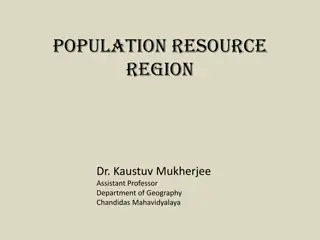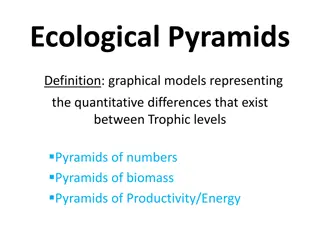Understanding Population Pyramids: Insights into Human Resource Trends
A population pyramid is a graphical representation that reflects the age structure of a population, revealing crucial insights into demographics and societal needs. Expansive pyramids depict young and growing populations, while constrictive pyramids signify aging societies. Understanding these population trends is essential for planning services like education and healthcare.
Download Presentation

Please find below an Image/Link to download the presentation.
The content on the website is provided AS IS for your information and personal use only. It may not be sold, licensed, or shared on other websites without obtaining consent from the author. Download presentation by click this link. If you encounter any issues during the download, it is possible that the publisher has removed the file from their server.
E N D
Presentation Transcript
DAR ES SALAAM SCHOOL OF JOURNALISM MODULE NAME: LIFE SKILLS MODULE CODE:GST 05105 DEPARTMENT :JOURNALISM MODULE LEVEL:5 MODULE SEMESTER: I TUTOR S NAME:AYUBU GAMBA OUR MOTTOR: MEDIA FOR DEMOCRACY
TOPIC 3: Population and Human resources What is Population? A population is a distinct group of individuals, whether that group comprises a nation or a group of people with a common characteristic. In statistics, a population is the pool of individuals from which a statistical sample is drawn for a study. Or typically refers to the number of people in a single area, whether it be a city or town, region, country, continent, or the world. Governments typically quantify the size of the resident population within their jurisdiction using a census, a process of collecting, analyzing, compiling, and publishing data regarding a population 2
TYPES OF POPULATION A population pyramid, or age structure graph, is a simple graph that conveys the complex social narrative of a population through its shape. Demographers use these simple graphs to evaluate the extent of development for a given population usually an individual nation and to make predictions about the types of services that population will need e.g. schools, hospitals, homes, etc. And while every population pyramid is unique, most can be categorized into three prototypical shapes: expansive (young and growing), constrictive (elderly and shrinking), and stationary (little or no population growth). Let s take a deeper dive into the trends these three shapes reveal about a population and its needs.
1.EXPANSIVE PYRAMIDS Expansive population pyramids are used to describe populations that are young and growing. They are often characterized by their typical pyramid shape, which has a broad base and narrow top. Expansive population pyramids show a larger percentage of the population in the younger age cohorts, usually with each age cohort smaller in size than the one below it. These types of populations are typically representative of developing nations, whose populations often have high fertility rates and lower than average life expectancies.
2. CONSTRICTIVE PYRAMIDS Constrictive population pyramids are used to describe populations that are elderly and shrinking. Constrictive pyramids can often look like beehives and typically have an inverted shape with the graph tapering in at the bottom. Constrictive pyramids have smaller percentages of people in the younger age cohorts and are typically characteristic of countries with higher levels of social and economic development, where access to quality education and health care is available to a large portion of the population.
3.STATIONARY PYRAMIDS Stationary, or near stationary, population pyramids are used to describe populations that are not growing. They are characterized by their rectangular shape, displaying somewhat equal percentages across age cohorts that taper off toward the top. These pyramids are often characteristic of developed nations, where birth rates are low and overall quality of life is high.
Population change, defined generally, is the difference in the size of a population between the end and the beginning of a given time period (usually one year). Specifically, it is the difference in population size on 1 January of two consecutive years. Population change has two components: natural population change (the number of live births minus the number of deaths); net migration (the number of immigrants minus the number of emigrants, plus statistical adjustment it should be noted that net migration as referred to in the context of population change statistics includes the statistical adjustments occurring in the annual balance of the population and that it serves the purpose of closing this balance).
Causes and rates of population change The three main causes of population change Births - usually measured using the birth rate (number of live births per 1,000 of the population per year). Deaths - usually measured using the death rate (number of deaths per 1,000 of the population per year). Migration - the movement of people in and out of an area.
i. Decline in the Death Rate: The fall in death rates that is decline in mortality rate is one fundamental causes of overpopulation. Owing to the advancements in medicine, man has found cures to the previously fatal diseases. The new inventions in medicine have brought in treatments for most of the dreadful diseases. This has resulted in an increase in the life expectancy of individuals. Mortality rate has declined leading to an increase in population. Owing to modern medications and improved treatments to various illnesses, the overall death rate has gone down. The brighter side of it is that we have been able to fight many diseases and prevent deaths. On the other hand, the medical boon has brought with it, the curse of overpopulation. ii. Rise in the Birth Rate: Thanks to the new discoveries in nutritional science, we have been able to bring in increase in the fertility rates of human beings. Medicines of today can boost the reproductive rate in human beings. There are medicines and treatments, which can help in conception. Thus, science has led to an increase in birth rate. This is certainly a reason to be proud and happy but advances in medicine have also become a cause of overpopulation ii. Rise in the Birth Rate:
iii. Migration: Immigration is a problem in some parts of the world. If the inhabitants of various countries migrate to a particular part of the world and settle over there, the area is bound to suffer from the ill effects of overpopulation. If the rates of emigration from a certain nation do not match the rates of immigration to that country, overpopulation makes its way. The country becomes overly populated. Crowding of immigrants in certain parts of the world, results in an imbalance in the density of population. iv. Lack of Education: Illiteracy is another important cause of overpopulation. Those lacking education fail to understand the need to prevent excessive growth of population. They are unable to understand the harmful effects that overpopulation has. They are unaware of the ways to control population. Lack of family planning is commonly seen in the illiterate lot of the world. This is one of the major factors leading to overpopulation. Due to ignorance, they do not take to family planning measures, thus contributing to a rise in population. 10
Full name: AYUBU GAMBA. Department: JOURNALISM. Email Address:agamba133@gmail.com Phone number:0769055073 CONTACT TUTOR IN CHARGE























